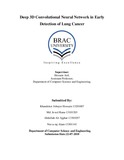| dc.contributor.advisor | Arif, Hossain | |
| dc.contributor.author | Hossain, Khandoker Jobayer | |
| dc.contributor.author | Rana, Md. Jewel | |
| dc.contributor.author | Ajghar, Abdullah Ali | |
| dc.contributor.author | Alam, Nur-a-taj | |
| dc.date.accessioned | 2019-01-24T09:16:42Z | |
| dc.date.available | 2019-01-24T09:16:42Z | |
| dc.date.copyright | 2018 | |
| dc.date.issued | 7/22/2018 | |
| dc.identifier.other | ID 13201007 | |
| dc.identifier.other | ID 13101203 | |
| dc.identifier.other | ID 13301057 | |
| dc.identifier.other | ID 13301141 | |
| dc.identifier.uri | http://hdl.handle.net/10361/11293 | |
| dc.description | Cataloged from PDF version of thesis. | |
| dc.description | Includes bibliographical references (pages 33-35). | |
| dc.description | This thesis is submitted in partial fulfilment of the requirements for the degree of Bachelor of Science in Computer Science and Engineering, 2018. | en_US |
| dc.description.abstract | Early detection of lung cancer is essential for the survival of patients. Lung Cancer remains the deadliest cancer in the world. Lung cancer diagnosis is still a time consuming and long awaiting process. The oncologist is facing tremendous workload for the diagnosis of lung cancer. The quality of their work is also deteriorating as work-pressure is increases. On the other hand, the number of cancer affected people is increasing day by day due to environment changes (environmental pollution, increase of UV radiation, increase of radiation substances in the environment, etc.). So, computer-aided-diagnosis systems can play an essential role to detect stage I lung cancer which may force the survival rate of lung cancer from below 20% to more than 70%. In this paper, we propose a model to detect the malignancy from a patient’s CT Scans using 3D convolutional neural network. We used lung CT volumes to train our model, which consists of Input layer, several Hidden layers, Fully Connected layers and finally the output layer to show the malignancy. The proposed system runs in a workstation with a moderate configuration and the output comes in a very short time. We do believe that, this application of deep 3D convolutional neural network will have a great impact in the field of medical science and cancer diagnosis. | en_US |
| dc.description.statementofresponsibility | Khandoker Jobayer Hossain | |
| dc.description.statementofresponsibility | Md. Jewel Rana | |
| dc.description.statementofresponsibility | Abdullah Ali Ajghar | |
| dc.description.statementofresponsibility | Nur-a-taj Alam | |
| dc.format.extent | 35 pages | |
| dc.language.iso | en | en_US |
| dc.publisher | BRAC University | en_US |
| dc.subject | Neural Network | en_US |
| dc.subject | CT scan | en_US |
| dc.subject | Lung segmentation | en_US |
| dc.subject.lcsh | Neural networks (Computer science) | |
| dc.title | Deep 3D convolutional neural network in early detection of Lung cancer | en_US |
| dc.type | Thesis | en_US |
| dc.contributor.department | Department of Computer Science and Engineering, BRAC University | |
| dc.description.degree | B. Computer Science and Engineering | |

